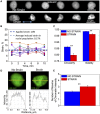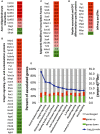Mechanical Strain Promotes Oligodendrocyte Differentiation by Global Changes of Gene Expression
- PMID: 28473753
- PMCID: PMC5397481
- DOI: 10.3389/fncel.2017.00093
Mechanical Strain Promotes Oligodendrocyte Differentiation by Global Changes of Gene Expression
Abstract
Differentiation of oligodendrocyte progenitor cells (OPC) to oligodendrocytes and subsequent axon myelination are critical steps in vertebrate central nervous system (CNS) development and regeneration. Growing evidence supports the significance of mechanical factors in oligodendrocyte biology. Here, we explore the effect of mechanical strains within physiological range on OPC proliferation and differentiation, and strain-associated changes in chromatin structure, epigenetics, and gene expression. Sustained tensile strain of 10-15% inhibited OPC proliferation and promoted differentiation into oligodendrocytes. This response to strain required specific interactions of OPCs with extracellular matrix ligands. Applied strain induced changes in nuclear shape, chromatin organization, and resulted in enhanced histone deacetylation, consistent with increased oligodendrocyte differentiation. This response was concurrent with increased mRNA levels of the epigenetic modifier histone deacetylase Hdac11. Inhibition of HDAC proteins eliminated the strain-mediated increase of OPC differentiation, demonstrating a role of HDACs in mechanotransduction of strain to chromatin. RNA sequencing revealed global changes in gene expression associated with strain. Specifically, expression of multiple genes associated with oligodendrocyte differentiation and axon-oligodendrocyte interactions was increased, including cell surface ligands (Ncam, ephrins), cyto- and nucleo-skeleton genes (Fyn, actinins, myosin, nesprin, Sun1), transcription factors (Sox10, Zfp191, Nkx2.2), and myelin genes (Cnp, Plp, Mag). These findings show how mechanical strain can be transmitted to the nucleus to promote oligodendrocyte differentiation, and identify the global landscape of signaling pathways involved in mechanotransduction. These data provide a source of potential new therapeutic avenues to enhance OPC differentiation in vivo.
Keywords: cell nucleus shape; chromatin remodeling; mechanical strain; mechanotransduction; multiple sclerosis (MS); oligodendrocyte differentiation; oligodendrocyte precursor cell (OPC); oligodendrocytes.
Figures






Similar articles
-
Differential roles of epigenetic regulators in the survival and differentiation of oligodendrocyte precursor cells.Glia. 2019 Apr;67(4):718-728. doi: 10.1002/glia.23567. Epub 2018 Nov 28. Glia. 2019. PMID: 30793389 Free PMC article.
-
High Mobility Group A1 Regulates Transcription Levels of Oligodendrocyte Marker Genes in Cultured Oligodendrocyte Precursor Cells.Int J Mol Sci. 2022 Feb 17;23(4):2236. doi: 10.3390/ijms23042236. Int J Mol Sci. 2022. PMID: 35216347 Free PMC article.
-
Expression and function of myelin-associated proteins and their common receptor NgR on oligodendrocyte progenitor cells.Brain Res. 2012 Feb 9;1437:1-15. doi: 10.1016/j.brainres.2011.12.008. Epub 2011 Dec 11. Brain Res. 2012. PMID: 22227458
-
Oligodendrocyte progenitor cell recruitment and remyelination in multiple sclerosis: the more, the merrier?Brain. 2022 Dec 19;145(12):4178-4192. doi: 10.1093/brain/awac307. Brain. 2022. PMID: 36093726 Review.
-
Convergent epigenetic regulation of glial plasticity in myelin repair and brain tumorigenesis: A focus on histone modifying enzymes.Neurobiol Dis. 2020 Oct;144:105040. doi: 10.1016/j.nbd.2020.105040. Epub 2020 Aug 13. Neurobiol Dis. 2020. PMID: 32800999 Review.
Cited by
-
Loss of HDAC11 ameliorates clinical symptoms in a multiple sclerosis mouse model.Life Sci Alliance. 2018 Sep 24;1(5):e201800039. doi: 10.26508/lsa.201800039. eCollection 2018 Oct. Life Sci Alliance. 2018. PMID: 30456376 Free PMC article.
-
Mechanotransduction: Exploring New Therapeutic Avenues in Central Nervous System Pathology.Front Neurosci. 2022 Apr 28;16:861613. doi: 10.3389/fnins.2022.861613. eCollection 2022. Front Neurosci. 2022. PMID: 35573316 Free PMC article. Review.
-
Mechanical Strain Alters Cellular and Nuclear Dynamics at Early Stages of Oligodendrocyte Differentiation.Front Cell Neurosci. 2018 Mar 6;12:59. doi: 10.3389/fncel.2018.00059. eCollection 2018. Front Cell Neurosci. 2018. PMID: 29559894 Free PMC article.
-
Differential roles of epigenetic regulators in the survival and differentiation of oligodendrocyte precursor cells.Glia. 2019 Apr;67(4):718-728. doi: 10.1002/glia.23567. Epub 2018 Nov 28. Glia. 2019. PMID: 30793389 Free PMC article.
-
Brief review: Can modulating DNA methylation state help the clinical application of oligodendrocyte precursor cells as a source of stem cell therapy?Brain Res. 2019 Nov 15;1723:146386. doi: 10.1016/j.brainres.2019.146386. Epub 2019 Aug 13. Brain Res. 2019. PMID: 31419426 Free PMC article. Review.
References
-
- Baer A. S., Syed Y. A., Kang S. U., Mitteregger D., Vig R., ffrench-Constant C., et al. . (2009). Myelin-mediated inhibition of oligodendrocyte precursor differentiation can be overcome by pharmacological modulation of Fyn-RhoA and protein kinase C signalling. Brain 132(Pt 2), 465–481. 10.1093/brain/awn334 - DOI - PMC - PubMed
Grants and funding
LinkOut - more resources
Full Text Sources
Other Literature Sources
Research Materials
Miscellaneous

